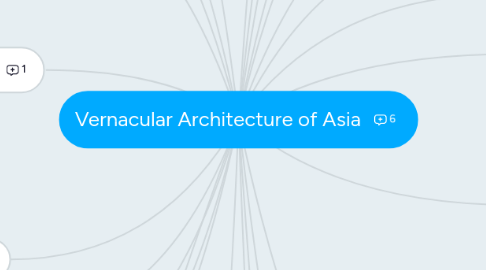
1. local/regional dialect
1.1. not homogeneous
1.2. identity of occupants
1.3. high level
1.3.1. sacred, cosmologies, world-views and philosophies
1.4. middle level
1.4.1. communicating identity, status, wealth and power the 'latent' aspects of settings and behaviour
1.5. low level
1.5.1. everyday and instrumental meanings
1.6. commonality
2. city is a place for the vernacular
2.1. urbanization-transformations
2.2. history emphasizes city's political and cultural role
2.3. 18th century, Europe_industralization
2.3.1. increase in trade
2.4. colonialism make city to grow?!
2.4.1. urbanization/sub-urbanization
2.5. from village to city
2.5.1. cities were designed and built according to the laws and rules of finance
2.6. continuous and adaption, response social and environmental constraints
2.7. transportation
2.8. materials
2.8.1. it is indigenous to the locality
3. cultural milieu
3.1. hierarchy that reflects the religious,social and economic order
3.2. cosmic centers?!
3.3. cultural diversity
3.4. tangible or intangible, we know it through the material world
3.5. at different meaning from high level, middle level to low level
3.6. how we experience the others' experience, it is a transition
3.7. how it can be expressed in different ways
3.8. inherited?! keep it or revolve, passing down the tradition, adapting and keep on changing to adapt the existing living context by great labor.
4. 8.formal/informal settlement & VA
4.1. informa=marginal buildings
4.1.1. natural process of migration to cities
4.1.2. outskirts of cities
4.1.3. hillside
4.1.4. no infrastructure
4.1.5. informal business/shadow economy
4.1.6. ownership
4.1.7. shadow developer
4.2. formal
4.2.1. a process of indvidual development
5. 9.conservation & built V. heritage
5.1. brings activities
5.2. conserve significance and values
5.3. respect=care continuing development of a place
5.4. not just a historical relic
5.5. carry out by multidisciplinary expertise
5.6. not only tangible but also intangible associations which attach to them
5.7. It is not an one-off effort, but one that is continuous.
6. preservation
6.1. frozen in time
6.2. preserve historical values
6.3. Nepal: caste system and feudal society society
7. value
7.1. social value
7.1.1. community value
7.2. architectural merits
7.3. aesthetic value
7.4. historical value
7.5. universal value
7.6. Vernacular architecture heritage is important because it epitomizes the world's cultural diversity.
7.7. environment reponsive
7.8. represents people
8. homogenisation
8.1. professional vs armature folk practice
9. hybridity vs pure
9.1. urban diversity
9.2. embodies human and economic relationships
9.3. not represented by a single type
9.4. intermingled
10. 10.sustainability
10.1. building decision
10.1.1. conscious or un self conscious
10.2. identity
10.2.1. personal
10.2.2. regional
10.2.3. national
10.3. village=microcosm of society
10.4. 1.physically sustainable
10.5. 2.culturally sustainable
11. 6. Rural vernacular:setting & settlement
11.1. setting is integral part of culture and surrounding
11.2. informal settlements
11.2.1. materials
11.2.2. patterns
11.2.3. piecemeal fashion
11.2.4. complex culture of material supply and expertise
12. 7.urban vernacular
12.1. colonialism
12.1.1. political
12.1.2. economy
12.1.3. culture
12.1.4. building type
12.1.5. time/continuous process
12.1.6. clans
12.2. places where there are a concentration of people, population, higher density, no sporadic
12.3. people you know and dont know vs people you know in village
12.4. diaspora
12.5. informal settlement
12.5.1. temporary materials
13. PARTICULAR Time,Location&People
13.1. Profession&Amateur
14. traditional&natural way
14.1. Song Dynasty (1128–1279)
14.2. Japanese machiya
14.3. courtyard house (siheyuan)
15. 1. waht is VS? continuing process
15.1. changes&adaptation
15.2. response social&environmental constraints
15.3. sharing
15.3.1. authenticity is kept&stretched out
15.4. transmitted informally by traditional expertise in design & construction
15.5. effective application in traditional construction systems and crafts
15.6. space-time continuum
16. typology = category
16.1. urban vernacular=evolove
16.1.1. culture economy
16.1.1.1. human economy
16.1.2. materials of buildings
16.1.3. business scale
16.1.4. complexity of production
16.1.5. built at a particular place and time
16.1.6. ordinary built form
17. relationship
17.1. neighborhood
17.2. street
17.3. people
17.3.1. people's behavior and custom
17.4. activities
17.5. relationship-"KAN"-man-built-nature
17.5.1. spiritual and cultural value
17.6. fengshui
18. VS indigenous
18.1. materials
18.1.1. indigenous=local
18.1.2. can be imported
18.2. function&cultural diversity
19. 2. P-C-VA: Level of vernacular architecture meaning
19.1. low level-everyday and instrumental meanings
19.2. middle level-to communicate the community's or the resident's identity,status,wealth and power
19.3. high level-sacred,cosmologies,world view,philosophies of thhe community,the clan or the family
19.3.1. Vassau Shatra in Sanskirit, hindu traditions
19.4. It is very difficult to distinguish the vernacular into low, middle or high level. But we can understand the vernacular architecture from its formation under the affecting of physical and mental. A hut can be a home for poor people, it also can be the sacred place for the literati.
19.4.1. add on meanings by users themselives
19.4.2. time as value
19.4.2.1. human touch/cross relationship
19.4.3. read the intention for the meanings
20. 3.VA & Climate response
20.1. needs of shelter
20.1.1. house types
20.2. building materials
20.3. living context
20.4. human activity
20.5. geographic mapping
20.6. generic design under the general lcal environmental condition
20.7. olgyaa1963
20.8. vernacular response
21. 4.materials
21.1. cultural
21.1.1. regionalism vs globalization
21.1.1.1. human scale
21.2. spiritual
21.2.1. ritual associate with preparing
21.3. natural or manufactured
21.3.1. ram earth, mud, wood
22. 5.Vernacular landscape
22.1. public
22.2. private
22.3. rural
22.4. urban
22.5. sense of place/genius loci
22.5.1. sensual and intellectual quality
22.6. man made landscape
22.6.1. cultural landscape
22.6.2. meaning of existence
22.7. natural landscape
22.8. cultural landscape or middle landscape
22.8.1. natural elements are transformed by human processes or actions into gardens etc by professions
22.8.2. The vast majority of cultural landscapes, however, have developed without the direct involvement of a professional designer, planner, or engineer.
22.9. 1_historic site
22.10. 2_Historic Designed Landscape
22.11. 3_Historic Vernacular Landscape
22.12. 4_Ethnographic Landscape
22.12.1. fengshui-Yin/Yang - place-to control vital life forces
